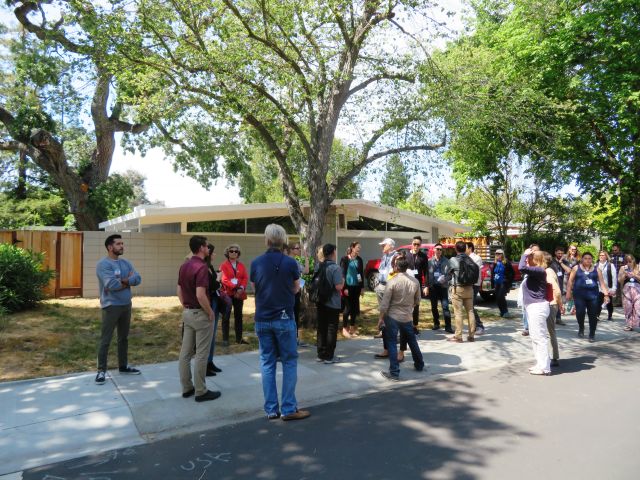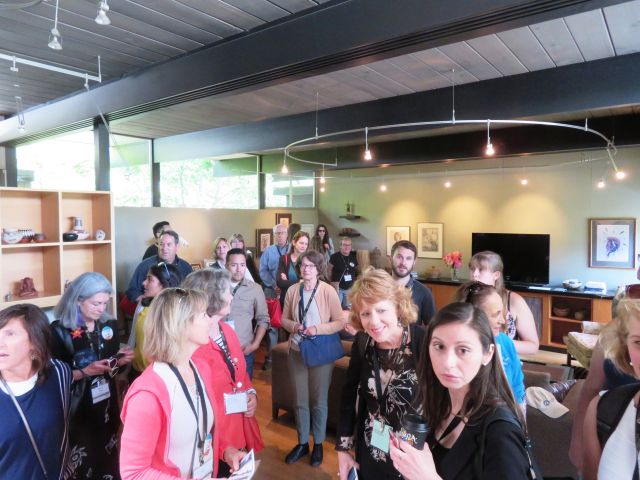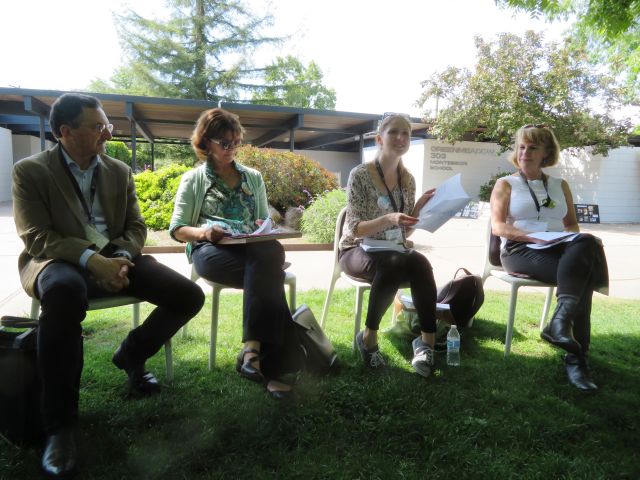
Eichler Events Are Popular at Conference
 |
|
|
When Jackie Wheeler saw 50-plus studious-looking people, many taking photos, walking through her neighborhood led by three tour guides, she did what any Eichler owner would do – she invited them into her house.
The occasion was ‘Tract Homes with a Tailored Look: Preserving the Character of Palo Alto’s Eichler Neighborhoods.’ It was one of two recent events at the 2018 California Preservation Conference, put on by the California Preservation Foundation and attracting about 550 people.
It was the first time the conference was held in Palo Alto in 30 years, and if you do a preservation conference in Palo Alto today you can’t avoid the Eichlers, which make up more than 2,500 of the city’s homes.
The homes have been much in the news recently as the city has devised guidelines to help preserve Eichler neighborhoods from the loss of privacy due to second-story additions and to larger, monster homes replacing one-story Eichlers.
 |
|
|
As a mobile workshop, with participants largely from the worlds of architectural history, architecture, and planning, the visit to the Eichler tract of Greenmeadow had a serious mien. That’s why Wheeler’s spontaneous invitation was such a delight.
With their cameras snapping away, the visitors enjoyed viewing Wheeler’s home and meeting both Jackie and her husband while chatting about life in the Eichler, the changing neighborhood, and changes in the house over the years.
The conference, which took place from Thursday May 17 through Sunday May 20, featured panels discussions, 'mobile workshops' like the one of Greenmeadow, full day tours, including one of the grand Filoli estate in Woodside, and several events that focused on modernism.
One such, a discussion of ‘Mid-century Modern: Case Studies in Survey Evaluation,’ sounded useful, with guidance for “local preservation advocates” and others seeking “strategies for conducting surveys with the use of volunteers” to determine if, say, a neighborhood could be deemed 'historic.'
Alas, it was the same time as the Eichler tour.
Another superb session focused on 'The Frank Lloyd Wright Legacy,' with talks about architects influenced by Wright, and about the challenges of preserving such Wright buildings as Fallingwater in Pennsylvania. (Until a project structurally reinforced the house, Fallingwater had indeed been falling.)
 |
|
|
The other Eichler-specific event, a showing of the film ‘People in Glass Houses’ followed by a panel talk, also proved popular.
Paul Adamson, one of the Eichler tour leaders along with Christina Dikas, Amy French, and K.C. Cullen, tied Eichler’s history and ethos to the very birth of the Modern Movement in architecture of the early 20th century.
“The beginnings of modern architecture in Europe were based on the idea of bringing quality design to workers’ housing in the capital cities of Europe,” said Adamson, author of ‘Eichler: Modernism Rebuilds the American Dream,’ “and I think of suburban development in the postwar period in the U.S. as being analogous.”
But with a big difference, he said. “The difference between the Modern Movement in Europe and what we saw develop in the U.S. suburbs in the postwar years was the quality of design,” he said, noting that American developers did not hire top architects – or any architects at all. But Eichler did.
“Eichers are, then, the rare exception,” Paul said.
 |
|
|
Paul, who referred to Eichler as a “businessman-artist,” recounted the tale of Joe admonishing homeowners not to paint their houses with inappropriate colors.
K.C. Cullen, an architect who has worked on Eichler homes and who once lived in Greenmeadow, discussed the communal aspects of life there, which are due in part to the neighborhood association’s ownership of its pool, park, and community center.
Cullen also recalled her years serving on Greenmeadow's committee that oversees architectural changes. One reason the effort proved generally successful, she said, was that the committee remained active from the start, since 1955.
That hasn’t been the case in every mid-century modern neighborhood.
Amy French, Palo Alto’s chief planning official, who grew up in a mid-century modern Mackay home adjacent to the Greenmeadow Eichlers, said, “There are 13 neighborhoods in town with single story overlays" designed to protect against two-story homes and loss of privacy. She added: “All just happen to be Eichler tracts,” though some 'Likelers' are mixed among them.
 |
|
|
Christina Dikas, from the firm Page & Turnbull, who helped design Palo Alto’s newly adopted, and voluntary, Eichler design guidelines, noted the importance of listening to residents in developing them.
“You really have to listen to what the values of the particular community are,” she said, noting that in Palo Alto the focus was on preserving backyard privacy, more than the architectural integrity of the homes as they face the street.
“There were actually a number of residents who felt they would rather have an addition...in the front of the property, if done well, instead of in the backyard,” Christina said.
Although the conference, in recent years, attracts mostly preservation professionals, architects, and city planners, some folks from local preservation groups and neighborhoods did attend, and at least one got something important out of a session.
Stephen Estes, who with some neighbors has been working for years to preserve tracts of mid-century modern Mackay homes in Santa Clara, came away with one potential solution – provide conservation easements on some of the homes.
The easements, which stay with buildings as they switch hands, place restrictions on what can be done to a building and authorize an outside preservation organization to see that the restrictions are enforced.
K.C. Cullen addressed the oft-heard worry that efforts to block development in neighborhoods decrease property values. Years ago, she said, when Greenmeadow became the second tract in town to block two-story homes or additions, “I remember a realtor telling me, ‘You can’t do this. If you do it you will put a $500,000 ceiling on the prices of these homes. They will never go above half a million.”
Homes in Greenmeadow start today at about $2 million, if you are lucky.
- ‹ previous
- 172 of 677
- next ›



